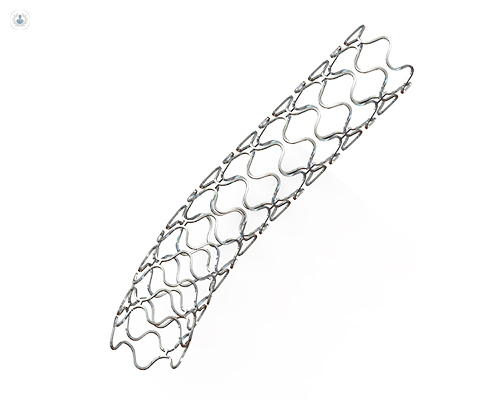



What is a stent?
A stent or endoprosthesis is a small, flexible tube, and is usually made of biocompatible plastic material. It is used to repair or support arteries, veins, and ducts in the body. There are several models and brands of stent to suit the person’s needs and the type of surgery.
Stent placement is aimed at strengthening the venous wall and facilitating proper blood supply to the body. This is a minimally invasive surgery and is usually carried out under general anaesthetic, though it may also be carried out under local anaesthetic, depending on the duct and pathology to be treated.
Why are stents used?
Stent placement is aimed at treating ducts that have become narrow or blocked due to disease. It is most commonly used in blood vessels, but can also be used in the oesophagus, bile duct, trachea and bronchi.
In the case of aortic aneurysms, a vascular stent is inserted through a small incision in the groin and is advanced through the femoral artery until it reaches the aorta and the location of the aneurysm, in order to strengthen the vessel wall.
When used in the oesophagus, the stent allows food to pass through. In the bile duct, it is used to open the duct to allow bile to pass into the intestine.
In the trachea and bronchi, the stent opens the vessels to allow normal breathing.
What does it involve?
The surgery involves making a small incision, usually in the groin, through which the stent is guided by a catheter through the iliac vessel to the site where it is to be implanted. This procedure may be complemented by follow-up X-rays (fluoroscopy or a CT scan) or ultrasound which will allow the vascular surgeon to monitor and verify the correct implantation of the stent.
The catheter will be removed once the endoprosthesis has been guided to the ideal location and is properly positioned in the vessel. The entire procedure usually takes around two hours.
Preparing for stent placement
Before the surgery, the specialist may request a diagnostic imaging test in order to observe the characteristics of the vessel to be treated. A medical history will also be taken to see if you are a candidate for surgery. You may not be a good candidate for a stent if the blood vessels are irregularly shaped, if the aneurysm is too large, if you are pregnant or if you have any condition that would contraindicate a 2-hour operation.
Just before surgery, the area of the groin where the incision is to be made will be cleaned and shaved, and you will be given a local or general anaesthetic. You may need to fast if you are having an anaesthetic.
Post-operative care
Normally, after the operation you will have to remain in a horizontal position for four to six hours. Your hospital stay will be from two to four days and, depending on the case, you may need to be monitored overnight in an intensive care unit (ICU).
During the postoperative days you may experience some groin discomfort, thigh swelling, a pinching sensation in the legs, fever and constipation.
Most stents require periodic checks to make sure that the treated vessel is functioning properly and that the endoprosthesis is in good condition.
Alternatives to stent placement
Stent placement is currently the most advanced and innovative procedure for repairing, opening and strengthening vascular ducts. The alternative to this procedure is conventional open surgery, which entails a larger incision and a higher risk of complications as well as a longer post-operative period.